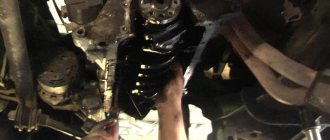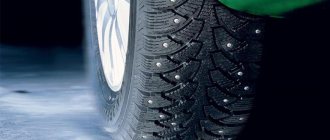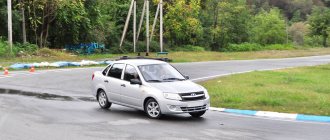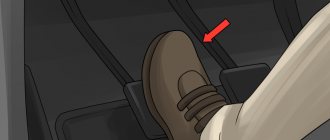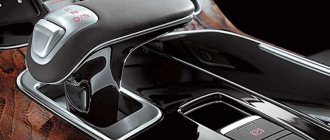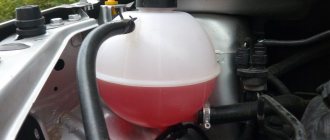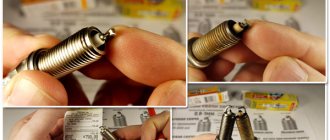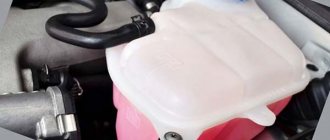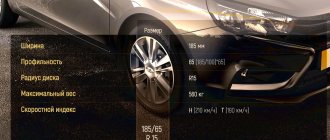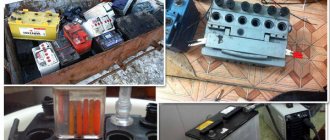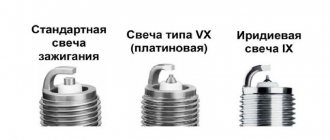Running in studded tires is a mandatory procedure that involves using the tire in a gentle mode to get used to the dynamics of acceleration/braking and for the studs to settle into place.
During break-in, it is prohibited to make sudden maneuvers and drive at speeds exceeding 60 km/h.
Below we outline the rules for running-in for tires of different models and provide recommendations for performing such work.
Let's figure out the reasons for the premature loss of studs, talk about the technology of making studded tires,
Causes of early loss of spines
During operation, drivers often encounter a situation where the studs fall out ahead of schedule, namely after one or two seasons.
There may be several reasons for this:
- Moving at increased speed. Leads to a greater load on the tenon with subsequent heating of the seating area and a decrease in the effectiveness of the adhesive in the socket.
- Sharp acceleration and braking. Active driving mode leads to loosening of the product in the socket, which is why it quickly jumps out of the recess.
- Incorrect tire pressure. A decrease in tire pressure below normal leads to an increase in the contact patch with the road. This leads to overheating of the tire, increased friction and premature falling out of the studs. Excessive inflation of the tire causes the central part of the projector to bulge, causing the spikes to come into closer contact with the surface and wear off.
- Frequent slippage. When the wheel rotates in one place, the spikes may not withstand the load upon contact with the road and fly out.
- Wear. During use, rubber loses quality, becomes stiffer and less elastic. Over time, damage appears, including at the nest site. The depression increases in diameter and the thorn falls out.
And to understand why running in studded tires is necessary, you need to know the principles of its manufacture. We will dwell on this issue in more detail below.
What is it for?
So, why do you need to break in winter studded tires? First of all, this is necessary for the driver. Do not forget that with such tires the vehicle will behave differently than with summer tires. The driver just needs some time to get used to it. However, this is only one of the reasons.
The studs on the rubber should find their place. Otherwise, they can be quickly lost. After all, if such rubber is used incorrectly, the studs can easily fly out. In addition, you can damage your tires. Running in winter studded tires will allow you to place the studs in their grooves. As a result, grip will improve, the vehicle will listen to the driver and the new tires will last more than 4 seasons.
Production technology of modern studded tires
Studring is a process that is carried out by the manufacturer with strict adherence to the number and quality of studs. These parameters are set by EU governments and all tire models must meet the requirements.
To attract buyers, manufacturers are trying to insert more studs into tires, using different technologies and placement patterns.
The work of installing studs is often carried out not in the country of the tire manufacturer, but at other factories located in the Russian Federation, China and other countries. This is done to reduce manufacturing costs and simplify delivery.
For example, the Pirelli and Michelin companies send tires for stud installation to Voronezh and Davydovo with subsequent transportation to one or another country.
Interestingly, the studs used for studding are not made by tire manufacturers, but by other factories.
The most popular manufacturers include Tikka, Turvanasta and Scason (Finland), Ugigrip (France) and Tecom (Russia).
Tecom - 12-8-2TR
Automatic tucking
The introduction of spikes can be fully automated with computer control. The latter, using sensors, determines the installation location and implements the product in a certain place.
After installing the tenon, its protrusion and indentation force are checked. To simplify the process, a special lubricating soap composition is used.
The technology described above is typical for most modern companies, but the manufacturer Continental has gone even further and uses a more serious technology in which the spike is “soldered” into the surface.
The algorithm of actions is as follows:
- Treating the spike with a thermoadhesive compound.
- Studring a tire blank (just called a blank).
- Vulcanization to give the correct shape and desired pattern.
- “Soldering” the stud and rubber to form a tight connection.
The use of this technology increases the reliability of the tenon fixation. To pull it out, it is necessary to apply a force of about 500 N*m, and this is an order of magnitude higher than during the usual studding process. Other companies have not yet been able to improve this parameter.
Hand tucking
Here the spikes are inserted by a human rather than a computer, which requires special attention from the performer. The products are inserted into the prepared recesses using a tool.
How long to run in
Unfortunately, the winter studded tire running-in indicator is not installed on all tires; it is quite difficult to accurately determine their readiness for the season. Therefore, each manufacturer recommends its own timing for such preparation. But how much do you need to drive if the manufacturer is silent about it? This question worries many drivers.
Any tires—summer, winter, studded, or with Velcro—requires running-in. A vehicle with new tires must travel at least 500 kilometers. During this time, the lubricant will be completely removed from the wheels, the studs will fall into place, and the rubber will be able to demonstrate all its qualities. In addition, the driver will be able to get used to the behavior of the vehicle.
So why do you need a break-in?
The fact is that the studs are inserted into the already welded tire by pressing it into the prepared holes (with the exception of some Continental models).
After studding, the tire must rest for 24 hours at a temperature of 20-25 0C and during this time the rubber flows into all the cracks, thus securing the stud.
But the fact is that even a perfectly tuned stud machine has its own tolerances for the protrusion of the stud above the tread surface, as a rule, this is 0.5 mm.
For this reason, some tenons will sit deep in the grooves, while others will not. And it is the running that will allow the studs to take their place in the tire, protruding to the same height.
Taking into account the above, there are several reasons why running in new studded tires is necessary:
- Establishing the correct position of the studs in the tire tread.
- Adaptation of driving style to new winter tires with individual characteristics.
- Removing excess debris and fluid residues that may have remained under the wheel studs.
All these measures will allow studded tires to last for two or more seasons with minimal loss of metal elements. There are cases when such tires have been maintained for 5 seasons.
When is the best time to do this?
This procedure is an important condition for road safety in winter, so it is recommended to carry it out no later than a few days before the onset of stable cold weather.
To prevent tires from letting you down, you need to monitor their pressure.
During the process, you should observe a reduced speed limit. It is also not recommended to roll tires with studs on wet road surfaces. It is extremely dangerous, and the first hundred kilometers are the most important and must be done on dry, comfortable asphalt. Otherwise, the machine may behave unpredictably.
With the appearance of ice, snow and frost, it will be very difficult to break in new winter tires, since such actions can lead to deformation of the studs, their falling out or displacement, which means the tire will be damaged.
Without running in, studded tires can cause inconvenience while driving.
Run-in according to the indicator
It was noted above that before starting the break-in, it is necessary to record the odometer readings. If you did not have time or forgot to do this, use the indicator readings.
Any new tire has an indicator notch (corrugation) near the metal insert.
After the indicator has been rubbed off on the asphalt, it is considered that the running-in of the new tire is complete and you can use it as usual.
Indicator monitoring requires periodic inspection of the tread, which becomes dirty during operation and requires cleaning from foreign objects.
The inspection can be carried out in parallel with checking the tire pressure level.
Some manufacturers use mini-grooves (Bridgestone) or special stickers (Nokian).
In each case, we can talk about the completion of the run-in based on the abrasion of the indicators.
An additional indicator is the lubricant that is applied to a new winter tire.
Before the lubricant evaporates, it is necessary to move smoothly and not exceed the maximum speed.
Subtleties of the process and advice from professionals
There are some nuances of the process, so it is important to listen to the advice of professionals. Answering the question of how to properly break in winter studded tires, experts note that the most important components should remain:
- careful driving style;
- speed limit.
Tires need to be inspected and maintained as often as possible: any debris or small stones stuck there should be removed.
Each manufacturer checks and tests tires before releasing them for sale.
Before driving and after a test run, it is worth checking and, if necessary, balancing the wheels, since after running in the direction of the studs changes slightly.
Which road is better to run in?
Compliance with the correct operating mode does not guarantee high-quality running-in. The success of the event depends on the correct choice of route.
To avoid problems, follow these tips:
- Run-in is carried out on a flat asphalt road at a temperature of zero to ten degrees Celsius.
- Avoid driving on country roads or dirt roads.
- Run on flat surfaces without holes or potholes to avoid damage to the studs.
- Park on level areas without adjacent to or driving over curbs.
The conditions considered are available not only in big cities, but also in small towns.
To extend the life of winter tires with studs, try to run them under the conditions stated above.
FAQ
Do I need to do balancing after running in winter tires?
During the “grinding in” process, small irregularities, sprues, and “stubble” are removed from the tire tread, so the distribution of masses changes, which is why balancing must be done even after the tires have been broken in.
Is it possible to break in winter tires at temperatures above zero?
Running in winter tires should be carried out precisely at above-zero temperatures on clean and dry asphalt, since the surface of the tires does not yet provide good grip on cold roads. In addition, running-in at sub-zero temperatures takes longer.
How long does it take to break in new winter tires?
The average running time for winter tires is about 500–1000 km and depends on its properties, type and conditions.
Features of running-in for different manufacturers
When producing a winter studded tire, the manufacturer can give its recommendations on how to properly run-in after installation on the car.
In most cases, they are 90% similar, but there are a number of features that require attention from the car owner.
Michelin
Michelin recommends running in winter tires as follows:
- Distance - from 800 to 1000 km.
- Travel speed is up to 70 km/h.
- No sharp braking or forced acceleration.
Continental
The manufacturer recommends running in its products taking into account the following recommendations:
- The first 700 km without any harsh braking/starting or lateral acceleration.
- The upper speed limit is up to 100 km/h.
- Gentle travel mode at the initial stage, quiet ride.
The manufacturer is confident that following these recommendations will allow you to get used to the features of winter tires and learn how to drive them correctly.
The exception is the Continental IceContact2 tires. They have studs glued into the rubber, which allows you to limit the break-in time to 100-200 km.
Hankuk
For this manufacturer, the running-in of new winter tires with studs is carried out according to the standard principles discussed above.
Nokian
When running in Nokian tires of models Norman 5, Hakapelita 8, Norman 7 and others, you need to focus on the indicator in the form of a picture.
As soon as it disappears, you can proceed to normal use. For the first 500 km, it is important to avoid sudden maneuvers, acceleration and braking.
How to properly break in your car's winter tires
For 500–1000 km after installing new friction or studded tires, it is necessary to observe a certain operating mode, which is called running-in. Running in winter tires allows them to get rid of factory lubricant, traces of flash, and minor manufacturing defects that inevitably form during the casting and vulcanization process. These features can negatively affect the grip properties of the rubber and shorten its service life.
Proper running-in of tires depends on their type: studded and friction (“Velcro”) tires behave differently, so the approach to “grinding in” is different, experts write.
Why do you need to break in winter tires?
The need to run-in winter tires with studs is determined by production technology. In the process of making studded tires, it is important to ensure a tight but relatively loose fit of the metal stud in the rubber. To ensure proper fastening and facilitate the filling of tenons with an automatic machine, the holes are treated with a special lubricant.
One of the purposes of running in winter studded tires is to remove this compound, which is not only not required during operation, but also creates additional problems. In addition, during rolling-in, the studs finally occupy their designed position in the tread, whereas on tires that have just come off the assembly line, the difference in location relative to the seating depth can reach fractions of a millimeter.
A greasy separator and lubricated stud sockets significantly impair grip.
with the road, which reduces the car's handling. On a slippery road, this can lead to a skid and an increased risk of an accident!
Taking into account these features of studded tires, a reasonable question arises: is it necessary to break in the friction rubber? It turns out that it is also necessary in this case, because a separating lubricant also remains on the surface of such rubber, which makes it easier to separate the product from the mold during the production process.
Remaining on the tire, it worsens the grip. There is another reason for running in winter studless tires - the need to erase the top layer of the tread, under which there are drainage channels and the working layer of the tire.
For studded tires, you should first stud them and then break them in. If you put studs into already used tires, it will be much more difficult to do this because the lubricant will be washed out and the holes will become clogged with dirt.
What determines the quality of tire running in?
The rules for running in winter tires are briefly reduced to maintaining a special driving regime. It is necessary to observe the speed limit, avoid sharp turns, acceleration and stopping. How many kilometers are needed to break in winter tires depends on a number of tire characteristics:
- Tire softness . This indicator is not reflected in the labeling, but is usually associated with operating temperatures and speed index. The lower the temperature and maximum speed, the shorter the run-in should be.
- Speed limit . The higher the maximum permissible speed of a tire, the stiffer it is, since it is designed for higher temperatures. The index determines the speed at which new winter tires are run in. For tires marked P and below, it is better to stick to 50–70 km/h, for Q and above – 70–80 km/h.
- Load index . Like the speed index, it affects the hardness of the rubber. Heavy-duty tires are stiffer than tires for small cars. Accordingly, if there is a weight reserve of more than 50% (for example, tires are installed on a pickup truck that can take on board up to 1 ton, but the running-in is done alone and without a load), then it is better to increase the running-in mileage as well.
- Tire type . Running in winter non-studded tires is carried out over a period of 500–700 km, studded tires – about 800–1000.
- Road conditions . Running in winter studded tires should be done at above-zero temperatures, before a persistent snow and ice cover forms on the roads. Running in Velcro winter tires is also better on a flat, clean road, when it is already cool, but there is no ice or snow yet. If it was not possible to “change your shoes” in time and severe frosts hit, then for running on snow and ice it is advisable to reduce the speed to 50–70 km/h, and increase the mileage to 1000–1500 km. This is due to the fact that in such conditions the tires behave worse and you cannot drive quickly, and contact with frozen water reduces the temperature of the rubber, making it harder.
- Pressure . The higher the operating pressure in the wheels, the longer the break-in procedure. It is enough to run soft tires, designed for pressures up to 2–2.3 bar (atmospheres), for 500 km, because they warm up better in operation, and hard tires with pressures of about 3 bar or more - more than 1000 km.
The main thing that determines the quality of tire running-in is driving style. Aggressive driving in winter is not only unsafe in itself, but also leads to accelerated tire wear. During sudden starts and braking, the studs, which have not yet firmly taken their position, easily fly out of their holes.
If you ignore running-in, you can quickly lose a significant part of the studs. Since they are effective only if at least 85% of the studs are retained, and the tread of studded tires holds the road worse than Velcro, driving on such tires will be dangerous in the future.
The marker signaling the end of the running-in period is the studded tire running-in indicator. Depending on the manufacturer, it may have different shapes:
- a pattern in the form of a snowflake or small stripes around a spike;
- small “pimples” less than 1 mm high;
- thin (less than 0.5–1 mm) strips across the tread elements;
- colored marks on the working side of the tread.
The same special tags can be used on Velcro, but they are less common.
Multi-colored stripes along the entire circumference of the tread are not an indicator. This is an internal factory marking that does not provide useful information for users and is often erased before the wheels are broken in.
How to properly break in new winter tires
The document “AE 001-04” mentions how to properly break in winter studded tires. Rules for the operation of car tires." From paragraph 80 it follows that running in new winter tires with studs should be carried out over a period of 800–1000 km . The document sets speed limits at 70 km/h for cars and 50 km/h for trucks . The experience of motorists shows that it is possible to safely deviate from these requirements by slightly increasing the speed of the passenger car, but you should not exceed 80 km/h .
The universal algorithm for running in winter studded tires looks like this:
- After mounting on a rim, new tires must be inflated to the required pressure and balanced.
The tire pressure of the vehicle is indicated in the vehicle's operating manual and on a sign in the doorway. - Drive the first 100–200 km using extreme care and caution.
Recommended speed is 50 km/h, with smooth starts and stops. Proper running-in of tires should be carried out at a measured pace, preferably outside of heavy traffic, since frequent stops prevent normal heating of the tires. After the initial run-in, you need to drive about 500 km, maintaining a speed limit of no more than 70–80 km/h and still avoiding sudden starts and stops. Running in winter tires works best when traveling over medium distances, about 100–200 km. - After 500 km, you need to check the condition of the tires and inspect the markers. If the running indicators are completely erased and there are no longer any traces of lubrication, then you can proceed to your normal driving style. If not, the process continues. You also need to pay attention to contaminants, which, if present, should be washed off.
- For the next 500 km, if the running-in has not yet taken place, you can slightly increase the speed, but sudden acceleration and braking should still be avoided.
- After driving about 1000 km on new tires, you need to inspect them again, check the break-in markers, as well as the presence of lubricant. If they still remain, or there are severe frosts outside (below -10°C), then it is advisable to drive another 300–500 km in break-in mode. After this, the tires should be run-in almost guaranteed.
If you have non-studded winter tires installed, the running-in follows a similar scenario, but with a reduced interval.
The first stage (especially careful driving) takes about 50 km, the next (main stage) – 200–300 km, the third – the same. After 500–600 km, the Velcro is almost guaranteed to break in. After installing studs, rubber for studded tires should be run in in the same way as studded tires. In this case, it is advisable to stick to slightly lower speeds, since self-mounted studs may hold up a little worse than factory ones and require more time to shrink.
Recommendations for proper running-in of studded winter tires
Basic recommendations on how to break in winter studded tires and tires without studs or studded tires are listed in the table below:
| Basic moments | Studded tires | Spiked tires | Friction tires |
| Recommended running speed, km/h | The first 100–200 km – 50 km/h. Further – up to 70–80 km/h. | The first 100–200 km – 50 km/h. Further – up to 70 km/h. | Up to 70–80 km/h. |
| Run-in duration, km | 800–1000 km, less often up to 1500 km. | About 500–700 km. | |
| Which road is better to drive on? | Clean, dry and smooth asphalt or concrete surface | ||
| At what temperature is it better to break in? | +5-7 degrees Celsius. At temperatures below 0 °C the running-in period must be increased. | ||
| Style of car operation during break-in | It is advisable to completely eliminate sudden starts, accelerations and braking. | Starting, accelerating and braking sharply is acceptable, but in moderation. Starting with sudden slipping and skidding braking should be avoided. | |
| The main sign of running-in | Abrasion of the indicator, usually located near the studs. | The break-in indicator is abraded and/or there are no traces of lubrication. | No traces of grease. Abrasion of traces of flash, sprues, and factory color marks on the working surface of the tread. |
To ensure that the running-in of new tires goes as smoothly as possible, it is advisable to be careful during it and adhere to the following tips:
- It is better to break in all 4 tires at once . It is not worth installing new tires on only one axle. Firstly, there is no benefit from this, and secondly, new and old tires behave differently and driving will be unsafe.
- Avoid sudden braking and acceleration as much as possible . During slipping or skidding, the studs are subjected to increased load. Until the lubricant is washed out and the spikes have not “settled”, much less force is required to pull them out.
- You can control the running-in by the placement of the studs and marks . During running-in, the indicators are erased, traces of lubricant are removed, and the studs fit more tightly into the holes. Lubricant residues can be identified by the shine of the rubber.
- During the break-in process, you need to maintain the cleanliness of the wheels and operating pressure . Pebbles stuck in the tread negatively affect the running-in process, and dirt adhering to the discs creates an imbalance.
Non-studded tires often do not have indicators indicating “running in”, so their running-in can be assessed by indirect signs. There should be no traces of flash and sprues, stripes and dots of in-plant markings and other signs that are not an integral part of the design on the working surface of the tread.
The logical conclusion of tire break-in is their re-balancing. After the break-in run, you need to visit a tire shop and restore the balance of the “used” tires.
Subscribe to KNEWS.KG in Google News and to our channel in Yandex.Zen, follow the main news of Kyrgyzstan and Central Asia in the KNEWS.KG telegram channel
If you find an error, please select a piece of text and press Ctrl+Enter .
Share
Mistakes when running in studded tires
Frequently made mistakes by car owners that lead to rapid loss of studs:
- Carry out running-in only on icy and snowy roads at a speed of 100 km/h. In this case, the spikes will begin to protrude strongly above the tread and will tear out when driving on asphalt, and the car will slide along the road (without ice and snow). This running-in method is only suitable for cars that take part in ice racing, and not for normal civilian use.
- Running in long trips on the highway without a break. This leads to overheating in the hole area and loss of the tenon. This area needs to cool down. Take breaks (see recommendations below).
- Carry out running-in in severe frost with short drives. The studs do not have time to warm up, and the factory lubricant under them does not have time to evaporate. The result will be a situation where, after the mileage set for the break-in, the car owner will think that the procedure is completed, but in fact this is not the case.
- Lack of control over tire pressure recommended by the manufacturer.
Dangerous grease
If you touch new tires, you can feel a slippery coating - this is factory lubricant. This compound clogs all the slots and grooves in the tread of new rubber. It's not very good. After all, such products will not provide reliable adhesion to the road surface. On the contrary, the vehicle will behave unpredictably. Where does the lubricant come from? This composition is applied to molds, into which the tires are then poured. Running in winter studded tires will help remove the grease. Gradually, the composition will be erased from the surface of the tires, and the grip will become more reliable.
